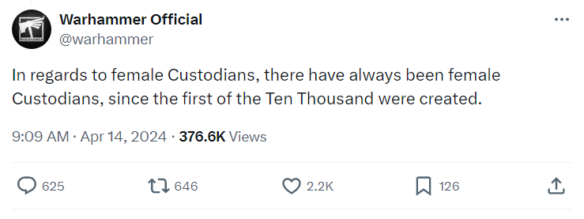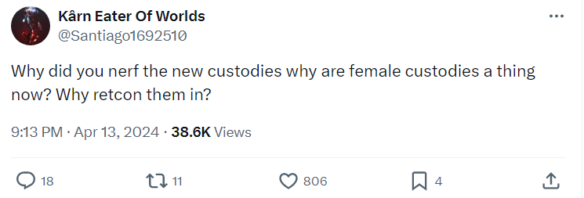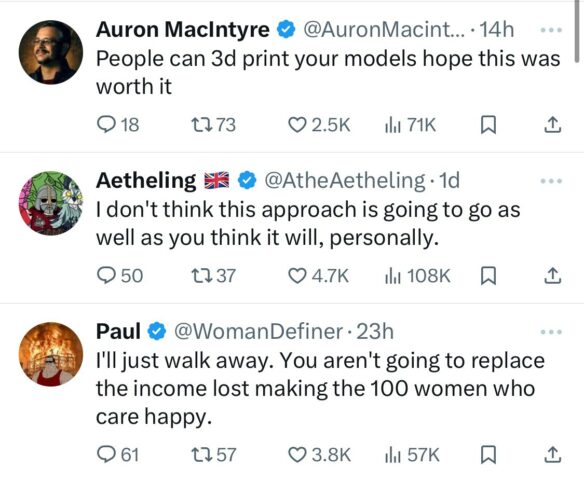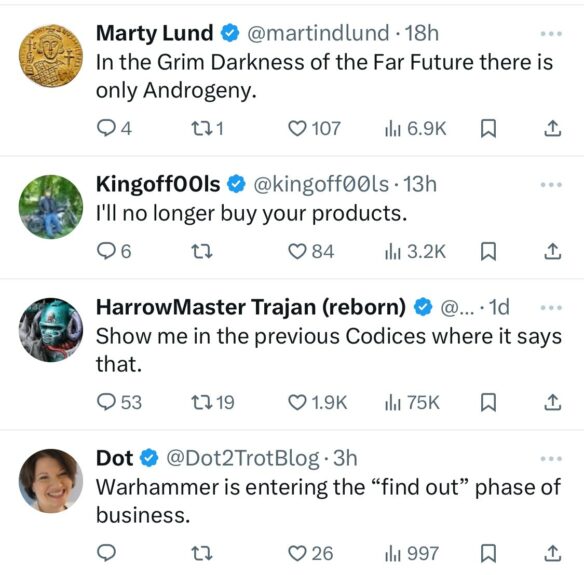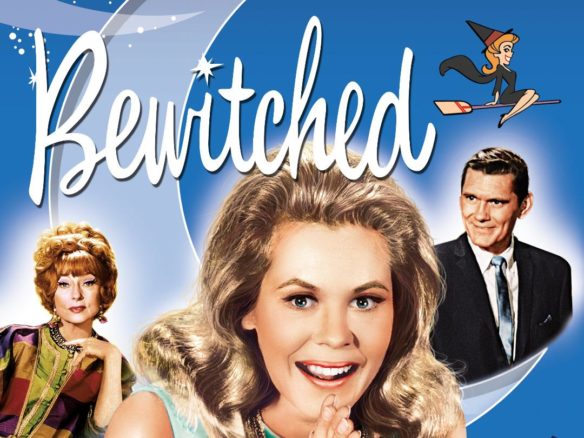(1) FRONT LINE GAMERS. The ChrisO_wiki on X.com has a long thread about the popularity of Warhammer 40,000 imagery among Russian and Ukranian fighters. One commenter calls it “a thread about the eclectic ideology of the current leadership of the Russian Orthodox Church, which could only be defined as a bizarre blend of traditional Russo-Soviet militarism and statism, wrapped around a pagan warrior cult.”
The entire thread can be accessed on the Thread Reader App. (What’s funny is that when I went there to look at it the first two ads shown in the thread were for toilet bowls. And since I haven’t been shopping for those online, the algorithim certainly didn’t get that idea from me!)
(2) DON’T PANIC…SO MUCH. McSweeney’s Internet Tendency mimics a professional pundit telling us “Here’s Why a Second Death Star Won’t Be That Bad”.
…I understand why people are worried, considering Palpatine has vowed retribution against Luke Skywalker, called the rebel alliance “the enemy within,” and vowed to banish millions of galactic migrants to the outer rim. But I believe that, deep down, below his contorted face, badly disfigured by the corrupting dark force surging through his veins, all Palpatine really wants to do is improve the economy. Heck, I wouldn’t be surprised if he pardoned Luke Skywalker and put this entire war behind him. Just because he’s never given the slightest indication that those are his true intentions doesn’t mean it can’t happen…
(3) SFWA FILLING VACANCIES. SFWA President Kate Ristau’s update to members today included news about changes to the organization’s staff.
In the past month, we hired a new controller and are settling in a new bookkeeper. These important roles will help continue to support our financial stability, with the leadership of our CFO, Jonathan Brazee. We have also reviewed procedures around financial transparency and fiscal responsibility. We are on a solid financial path, with healthy reserves.
After thirteen years as our Executive Director, Kate Baker will be stepping down at the end of November. We are grateful for Kate’s service and support. Former SFWA President Russell Davis has stepped in as Interim Executive Director, and we expect a full, open, and transparent hiring process to begin in the coming weeks. This process will take the hiring committee time as we restructure and look for an executive who can collaboratively guide SFWA into the future.
(4) HORROR REVIEWS. Lisa Tuttle’s “The best recent science fiction, fantasy and horror – reviews roundup” for the Guardian covers Blood Over Bright Haven by ML Wang; Jackal by Erin E. Adams; The Road to Roswell by Connie Willis; Curdle Creek by Yvonne Battle-Felton; and The Incubations by Ramsey Campbell.
(5) WHY DO TOOLS FALL IN LOVE? The name of the play is “Maybe Happy Ending.” “A New Broadway Musical Asks: Can Robots Fall in Love?” (Article is behind a New York Times paywall.)
…The story is about two outcast helperbots who meet at a robot retirement home and build a relationship while grappling with their own obsolescence, and Park thinks it is especially relatable after the coronavirus pandemic. “People have become so comfortable staying alone in their rooms and connecting to each other through a screen,” he said in a recent interview in Midtown Manhattan.
Shortly after previews began last month, Park, 41, a former K-pop lyricist who wrote the show’s lyrics, and Aronson, 43, who wrote the music — both collaborated on the book — talked about their inspirations and the different approaches to developing the show’s Korean and English versions. In a separate video call, Criss, 37, and Shen, 24, discussed the challenges of playing robots who look like humans.
Here are five things to know….
… The actors have a unique challenge.
The script spells it out: Oliver (Criss) and Claire (Shen) are robots who look like humans (they are dressed like hipsters, circa 2010).
Criss’s robot is an older model, so he, Shen and the production’s director, Michael Arden, decided that he would be the more robotic of the two main characters. That allowed Criss to draw on his training in physical theater at the Accademia dell’Arte, the performing arts school in Arezzo, Italy.
“The fear for an actor on a stage is to be like a cartoon character,” said Criss, who cited Kabuki theater, vaudeville and silent-film-era comedians as inspirations for his character’s movements and expressions. “However, because of the construct of our show, which is extremely theatrical and heightened, the more you lean into that, I think the more effective the piece.”
As for Shen’s character, the group decided that, because she was a newer model, her movements would be nearly indistinguishable from a human’s.
“It was interesting to get to work in that middle ground, that gray area,” she said.
(6) GOLDSMITHS PRIZE. The winner of the 2024 Goldsmiths Prize has been announced. This year, neither the winner nor the other shortlisted books were detectably of genre interest:
- Parade (Rachel Cusk, Faber)
The prize, worth £10,000 and run in association with the New Statesman, was open to novels published between 1 November 2023 and 31 October 2024, written in English by citizens of the UK or Ireland, or authors who have been resident in either country for three years and have their book published there.
(7) TODAY’S BIRTHDAY.
[Written by Paul Weimer.]
Born November 9, 1934 — Carl Sagan. (Died 1996.)
By Paul Weimer: Billions and Billions of milliseconds of my life have been influenced by Carl Sagan.
It all started with Cosmos, the original TV series. I heard about it (in TV Guide!) and wanted desperately to watch it in the hallowed year of 1980. I was entranced from the first episode, which had such diverse ideas as the cosmic calendar, the Library of Alexandria and much more. Cosmos became important must see viewing for me, and in an age before I had a VCR, I tried to use a tape recorder to capture an episode (“Heaven and Hell”, on Venus and global warming). I was entranced and Carl Sagan is directly responsible for me being fascinated with science in general and biology and astronomy in particular. He kindled the love of science in me. While I did not ultimately end up as a scientist, my love of science grew hand in hand with my love of science fiction, and Sagan is the person to thank and point to for that.
Besides Cosmos, his last major work, Pale Blue Dot, stands as a book that very darkly and presciently has foreseen our current political environment, where ignorance and misinformation, particularly around science, has become public policy for the Republicans. Sagan’s warnings, as well as his love of science and his defense of science as an idea, a process, that is ultimately not just worthwhile…but vital to our future.
Sagan has written other books as well, and has been an influential figure, good and bad for a long time (I remember an Omni magazine comic that posted and posited him as a villain covering up evidence of aliens having visited Mars. That…was a bit of a shock).
In order to celebrate Carl Sagan’s birthday, you must first invent the universe.


(8) BRADBURY, SAGAN, AND CLARKE AT CALTECH. And we’re only a couple days away from the anniversary of the panel that gave rise to Mars and the Mind of Man, a non-fiction book chronicling a public symposium at Caltech on November 12, 1971 featuring Ray Bradbury; Arthur C. Clarke; Bruce C. Murray; Carl Sagan and Walter Sullivan. The symposium occurred shortly before the Mariner 9 space probe entered orbit around Mars.
In this excerpt from the panel, Bradbury reads his poem “If Only We Had Taller Been”.
(9) COMICS SECTION.
- Frazz disagrees with Vonnegut.
- Carpe Diem needs caffeine.
- Saturday Morning Breakfast Cereal reveals the hidden danger.
- Tom Gauld reduces the crime rate, in a manner of speaking.
(10) SO IT GOES. Steven Heller interviews artist Igor Karash about his illustrations for Easton Press’ forthcoming limited edition of Slaughterhouse-Five. “Kurt Vonnegut’s Time Traveler Reimagined” at PRINT Magazine.
You mentioned that you started working on it at the outset of the Ukraine-Russia war. How did it impact your work?
Not in the greatest way. When I started developing the visuals, I was predominantly moved by the idea of examining the “horrors of war,” bouncing on the borderline between the darkest side of human nature and the paradoxical presence of good (this is the main message of the book for me). And then, the first war on the European continent since WWII turned everything upside down. Ukraine for me isn’t just another country—this is where I went to art school, where I met my wife, and where both of my children were born. From day one of the Russian invasion I was closely watching and following all news from Ukraine, contacting my friends there, etc., and almost immediately my drawings of the “horrors of war” on the surface of my drawing tablet started to feel bleak, unimportant and fake compared to the tragic reality unfolding before me, and I more deeply sunk into the hole of “PEOPLE DO NOT LEARN FROM THEIR PAST. SO IT GOES.” It took me a while to find enough inner peace to continue the project.

(11) WARNING AGAINST CHATBOTS. [Item by Steven French.] The UK’s communications regulator has warned digital platform companies that ‘chatbots’ which imitate either real or fictional people, alive or dead, could fall afoul of new online safety laws: “Ofcom warns tech firms after chatbots imitate Brianna Ghey and Molly Russell”.
Ofcom said it had issued the guidance after “distressing incidents”. It highlighted a case first reported by the Daily Telegraph where Character.AI users created bots to act as virtual clones of Brianna, 16, a transgender girl who was murdered by two teenagers last year, and Molly, who took her own life in 2017 after viewing harmful online content.
It also pointed to a case in the US where a teenager died after developing a relationship with a Character.AI avatar based on a Game of Thrones character.
(12) NEUROMANCER MUSICAL ACCOMPANIMENT. [Item by Steven French.] If you’ve ever listened to Gibson’s Neuromancer in audiobook format, the soundtrack is now available separately: “Neuromancer | Black Rain | Room40” at Bandcamp.
From Lawrence English
It’s hard to imagine that this year William Gibson’s Neuromancer celebrates its 40th anniversary. Having recently re-read the book for the first time in a great many years, the world building Gibson undertook in that text and the lingering cultural spectres he conjured, feel ever so evocative of moments of our contemporary lived experience. The books continued cultural resonance has resolved in a way that captured a future reading of an, at that time of its release, unknown internet era. It was an era of promise, and imagination, of speculative hope and down right uneasiness in equal parts.
In 1994, as the books 10th anniversary was on hand, New York duo Black Rain were commissioned to make a soundtrack to the audio book version of Neuromancer. Read by the author himself, this document, originally publish on a series of cassettes, would go on to be recognised as a unique glimpse into Gibson’s sensing of the characters and places that make up the Neuromancer zone.
Following a period of work as an expanded collective, Stuart Argabright and Shinichi Shimokawa, the two core members of Black Rain, decided to strip back their unit largely to a duet format. Their focus became more engaged around studio practice, and it was this refocusing that was ultimately serendipitous. As they started work on Neuromancer a number of new approaches and techniques emerged and with them came a new sonic language the pair had only imagined previously.
The audio book was a huge success and the soundtrack too was recognised for its brooding and post-industrial electronic grind. Since that time however, the recordings have largely remained in obscurity. While a couple of the pieces have surfaced in various editions including an excellent compilation by Blackest Ever Black, the entire suite of pieces has remained unpublished until this moment.
Working off the original master tapes, this edition (like the book), folds and morphs over itself in an episodic stratification. Pieces emerge, like strange architecture, from one another forming a sonic environment that feels almost tangible. I spent many weeks working on these tapes and also on the connections between the pieces. In collaboration with Stuart, our joint aim was to create a version of the soundtrack that speaks to the very atmosphere of the text itself. It’s a delight to share this collection of work for the first time.
(13) TUNING INTO THE MILKY WAY. [Item by Steven French.] How to build your very own handy-dandy radio telescope using only “a 1-meter satellite dish, a Raspberry Pi, and some other basic electronics such as analog-to-digital converters” (and an empty washing up liquid bottle – sorry, channelling old memories of kids tv programmes!): How to build a home radio telescope to detect clouds of hydrogen in the Milky Way (phys.org) at Phys.org.
…If I ask you to picture a radio telescope, you probably imagine a large dish pointing to the sky, or even an array of dish antennas such as the Very Large Array. What you likely don’t imagine is something that resembles a TV dish in your neighbor’s backyard. With modern electronics, it is relatively easy to build your own radio telescope. To understand how it can be done, check out a recent paper by Jack Phelps posted to the arXiv preprint server….
(14) THE QUIET FAN. The example of 2001 to the contrary, “Blue Danube” is not what a space traveler hears as he arrives at an orbital facility. “Space stations are loud — that’s why NASA is making a quiet fan” at Space.com.
Despite the International Space Station being comparable in size to a five-bedroom house, the prospect of spending months confined to a building that floats 250 miles (402 kilometers) above the Earth would be daunting for many.
You’d have to deal with limited space, a lack of privacy, the knowledge that you’re being watched, and the difficulty of performing everyday tasks in a zero-gravity environment. One thing we don’t often consider, though, when it comes to living on the International Space Station (ISS), is the sound. The constant hum of fans keeping crucial life support systems and instruments cool could get to anyone after a while, and there is nowhere to escape it.Thankfully, NASA researchers have developed a new “Quiet Space Fan” to reduce noise on crewed spacecraft, a design they plan on sharing with the industry for future use on commercial space stations.
By reducing noise at the source, NASA hopes people will be able to hear each other more clearly, become aware of alarms faster, and reduce risk of hearing loss, along with mitigating the irritation that loud, unwanted sounds can incur….
[Thanks to Steven French, Kathy Sullivan, Teddy Harvia, Mlex, Jo Fletcher, Paul Weimer, Mike Kennedy, Andrew Porter, John King Tarpinian, Chris Barkley, Cat Eldridge, and SF Concatenation’s Jonathan Cowie for some of these stories. Title credit belongs to File 770 contributing editor of the day Cat Eldridge.]


